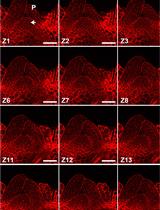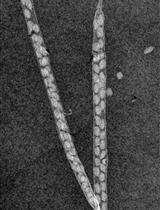- EN - English
- CN - 中文
Measuring Extracellular Proton and Anionic Fluxes in Arabidopsis Pollen Tubes
拟南芥花粉管细胞外质子和阴离子通量的测定
发布: 2021年02月05日第11卷第3期 DOI: 10.21769/BioProtoc.3908 浏览次数: 4269
评审: Agnieszka ZienkiewiczMichael WudickAnonymous reviewer(s)
Abstract
The ion-selective vibrating probe has been used to detect and quantify the magnitude and direction of transmembrane fluxes of several ions in a wide range of biological systems. Inherently non-invasive, vibrating probes have been essential to access relevant electrophysiological parameters related to apical growth and morphogenesis in pollen tubes, a highly specialized cell where spatiotemporal tuning of ion dynamics is fundamental. Of relevance, crucial processes to the cell physiology of pollen tubes associated with protons and anions have been elucidated using vibrating probes, allowing the identification of diverse molecular players underlying and regulating their extracellular fluxes. The use of Arabidopsis thaliana as a genetic model system posed new challenges given their relatively small dimensions and difficult manipulation in vitro. Here, we describe protocol optimizations that made the use of the ion-selective vibrating probe in Arabidopsis pollen tubes feasible, ensuring consistent and reproducible data. Quantitative methods like this enabled characterizing phenotypes of ion transporter mutants, which are not directly detectable by evident morphological and reproductive defects, providing valuable insights into molecular and cellular mechanisms. The protocol for quantifying extracellular proton and anionic fluxes detailed here can be adjusted to other systems and species, while the sample preparation can be applied to correlated techniques, facilitating the research of pollen tube growth and development.
Keywords: Ionic fluxes (离子通量)Background
The relevance of bioelectricity and ion exchange for living cells is unquestionable, having a functional impact in a range of phenomena, from pattern formation, signaling and development to cancer and other diseases (Levin, 2014). Diverse techniques can be employed to detect action potentials, electric fields, extracellular electric currents, and ion fluxes. However, the assessment of their function in vivo requires non-invasive methods. Ideally, any biological system of interest should be studied with the minimum interference and under the most physiological condition possible. Such criteria are attained by the non-invasive ion-selective vibrating probe, which has been used for measuring multiple transmembrane ion fluxes in a wide variety of experimental systems, including Drosophila (Browne and O’Donnell, 2016), zebrafish (Guh et al., 2016), mouse skin (Sun et al., 2015), roots (He et al., 2015), Daphnia (Stensberg et al., 2014), C. elegans (Adlimoghaddam et al., 2014), etc. In pollen tubes, quantitative measurements of extracellular ion fluxes using the ion-selective vibrating probe have been fundamental in establishing the role of major ions (especially Ca2+, H+, K+, and anions) in apical growth. When used in association with reverse genetics and pharmacology targeting specific molecular players, these methods also allowed the identification of mutation effects and subtle phenotypes, such as through quantitative analysis of aberrant oscillatory behavior (Certal et al., 2008; Michard et al., 2011 and 2017; Portes et al., 2015; Wudick et al., 2018; Hoffmann et al., 2020).
The ion-selective vibrating probe is a technique designed to reduce the electric noise related with ionophore loaded, glass microelectrode probes, bringing the signal/noise ratio to levels compatible with the measurement of physiological extracellular electric/ionic currents, associated with single cells and other biological systems (Shipley and Feijó, 1999; Kunkel et al., 2006). The experimental setup comprises a customized microelectrode, front-loaded with ion-selective ionophore cocktails (LIX) that measures the voltage at two locations at close vicinity of the plasma membrane (with µm precision), so that most noise and drift induced bias is subtracted from the final output. In the described protocol/setup, two routines allow for extra quantitative precision: on one hand, the background reference is measured away from any cell and also subtracted from the final voltage difference for convection, thermal or ionic gradient compensation; on the other hand, background concentration of the measured ion is continuously monitored, allowing the quantitative normalization of the fluxes in real time using Fick’s laws of diffusion.
The entire setup consists on an inverted microscope, nanometer 3-D positioners, and electrode impedance/capacitance correcting amplifier head stages, all placed inside a Faraday’s cage to reduce environmental electrical noise. Individual probes are calibrated at the start and end of experiments by measuring their potential in 3 appropriate solutions with concentrations ranging 3 orders of magnitude, deemed usable if closer than 95% to the Nernstian potential over the reference solutions. All experimental output is generated by an external, variable-gain amplifier with an analog read-out, and fed through an A/D board into a dedicated computer. All data processing including the calibration procedure, probe quality control, 3-D stepper motor-driven probe positioning and movement (vibration) system is performed by the ASET software (Automated Scanning Electrode Techniques - Applicable Electronics). The spatial resolution is limited by the dimension of the probe tip, usually at 1-3 μm of diameter, allowing sampling of small and specific patches at the cell surface. Depending on the ion, flux resolution goes into the pmol cm-2 s-1 range (Shipley and Feijó, 1999; Kunkel et al., 2006).
The use of a first-generation wire/voltage detection vibrating probes led to the discovery of an electric field around pollen tubes, which have been proposed to be cells behaving as electrical dipoles (Weisenseel et al., 1975). While highlighting the importance of ion dynamics for pollen tube growth and development, these early measurements and interpretative models were affected by technical artefacts of these early wire electrode probes, namely the stirring induced by the hundreds of Hz vibration needed for the noise subtraction by lock-in amplifiers. Discussing these limitations (e.g., Shipley and Feijó, 1999) allowed to assess ionic derived currents, and the subsequent development of ion-specific glass microelectrodes methods. Besides measuring only a specific ion, instead of the electric current stemming from the sum of all ion transport over a given surface, it also vibrates at very low frequencies (< 0.5 Hz) thus respecting the formation and stability of ion gradients over the cell surface during data acquisition. The resulting extensive effort led to the description of ion dynamics of pollen tubes in species as lily and tobacco (Feijó et al., 1999; Certal et al., 2008, Michard et al., 2008). The adoption of such species as study models was presumably related to the convenience of appropriated cell dimensions and high pollen germination and pollen tube growth rates, making them easy to obtain and experimentally manipulate in vitro. Despite the progress made using these species, the search for molecular mechanisms related to apical cell growth and sexual plant reproduction required the adoption of Arabidopsis thaliana as a genetic model. The application of these techniques to study ion dynamics and morphogenesis in Arabidopsis pollen is challenging due to the reduced dimensions of the flowers and difficulties in pollen manipulation in vitro. Besides these complications, the development of sophisticated molecular and genetic tools available for Arabidopsis required substantial protocol adaptations and optimizations, which were crucial for obtaining consistent data. Efforts to develop these protocols and approaches allowed the molecular identification and cellular localization of many ion transporters underlying the ion fluxes using ion-specific vibrating probes, together with the identification of key players involved in regulating ion homeostasis and morphogenesis in pollen tubes (reviewed in Michard et al., 2017).
The importance of protons and anions for pollen tube growth has been reported in diverse studies, where the presence of an intracellular gradient of these ions and the identification of the ion transporters promoting their movement was determined (Zonia et al., 2002; Michard et al., 2008; Gutermuth et al., 2013; Domingos et al., 2019). Of relevance, protons have been reported to enter mainly at the tip and generalized efflux occurring along the tube shank and pollen grain (Feijó et al., 1999; Certal et al., 2008; Hoffman et al., 2020). Anions, deemed as mostly chloride (Cl-) for being the only anion in the germination medium, have been shown to have an opposite flux direction, with influx along the pollen tube and grain and massive efflux at the tip (Zonia et al., 2002; Gutermuth et al., 2013; Domingos et al., 2019). Herein, a detailed description of the sample preparation and experimental protocol for measuring proton and anionic fluxes in pollen tubes with the ion-selective vibrating probe is presented.
Using quantitative techniques able to access measurable variables and parameters is complementary to genetics and imaging tools, offering a complete tool kit for characterizing mutant phenotypes. In this context, the use of ion-selective vibrating probes allowed the identification of phenotypes being otherwise undetectable, once diverse mutations do not display evident morphological and reproduction defects due to the high genetic redundancy and other compensatory mechanisms present in pollen tubes (Gutermuth et al., 2013; Wudick et al. 2018; Domingos et al., 2019). Experimental approaches coupling biophysical with molecular data are fundamental for an integrated and multidisciplinary investigation, contributing to better understand the mechanisms regulating intracellular cell physiology. The detailed protocol described below can be easily reproduced and adjusted to other systems, also enabling interested researchers to study pollen tube growth and development.
Materials and Reagents
Reference electrode – Dri-Ref (World Precision Instruments, catalog number: DRIREF-2 )
Glass microfiber filters (Sigma-Aldrich, catalog number: WHA1820047 )
Safe-Lock tubes, 1.5 ml (Eppendorf, catalog number: 0030120086)
Acrylic rectangular dish with a round chamber of 10 mm (custom-made) being the commercial equivalent the glass bottom dish (Cellvis, catalog number: D35-10-1-N )
Cover slip (Fisher Scientific, catalog number: 12-545 )
Glass syringe (Hamilton, catalog number: 80600 )
Silica gel (Sigma-Aldrich, catalog number: 13767 )
Silver/silver chloride wire (Fisher Scientific, catalog number: AA41390G2 )
Borosilicate glass capillaries (World Precision Instruments, catalog number: TW150-4 )
N,N-Dimethyltrimethylsilylamine (Sigma-Aldrich, catalog number: 41716 )
Hydrogen ionophore II-cocktail A (Sigma-Aldrich, catalog number: 95297 )
Chloride ionophore I-cocktail A (Sigma-Aldrich, catalog number: 99408 )
Sucrose (Sigma-Aldrich, catalog number: S7903 )
Potassium chloride (Sigma-Aldrich, catalog number: P9333 )
Magnesium sulfate (Sigma-Aldrich, catalog number: 746452 )
Boric acid (Sigma-Aldrich, catalog number: B6768 )
Calcium chloride (Sigma-Aldrich, catalog number: C1016 )
4-(2-Hydroxyethyl)piperazine-1-ethanesulfonic acid (HEPES) (Sigma-Aldrich, catalog number: H3375 )
Poly-L-lysine solution (Sigma-Aldrich, catalog number: P4707 )
Agarose low gelling temperature (Sigma-Aldrich, catalog number: A9045 )
Germination medium (see Recipes)
Stock solutions (see Recipes)
Equipment
pH meter
Vortex
Microwave
Oven
Desiccator
Fine needle-sharp tweezers (Sigma-Aldrich, catalog number: T4537 )
Benchtop microcentrifuge (Eppendorf, model: 5415D )
Micropipette puller (Sutter Instrument Company, model: P-97 )
Ion-Selective Vibrating Probe (System Applicable Electronics, model: SIET-Scanning Ion-selective Electrode Technique )
Inverted microscope (Nikon, model: Eclipse TE300 )
Microscope light power supply (Nikon, model: TE-PS100 )
Camera (Andor, model: iXon3 )
60x/1.40 Objective lens oil immersion (Nikon, model: Plan Apo )
Procedure
文章信息
版权信息
© 2021 The Authors; exclusive licensee Bio-protocol LLC.
如何引用
Portes, M. T. and Feijó, J. A. (2021). Measuring Extracellular Proton and Anionic Fluxes in Arabidopsis Pollen Tubes. Bio-protocol 11(3): e3908. DOI: 10.21769/BioProtoc.3908.
分类
植物科学 > 植物发育生物学 > 形态建成
生物物理学 > 电生理
细胞生物学 > 基于细胞的分析方法
您对这篇实验方法有问题吗?
在此处发布您的问题,我们将邀请本文作者来回答。同时,我们会将您的问题发布到Bio-protocol Exchange,以便寻求社区成员的帮助。
提问指南
+ 问题描述
写下详细的问题描述,包括所有有助于他人回答您问题的信息(例如实验过程、条件和相关图像等)。
Share
Bluesky
X
Copy link












